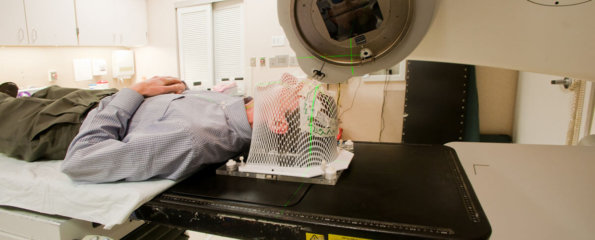Lower radiation doses could have big impact on cancer treatment
VectorLAB, a joint venture collaboration of physicists from the University of Sydney and Chris O’Brien Lifehouse, has developed a theoretical model that should allow radiation oncologists to better target cancer cells while leaving healthy tissue unaffected.
Taken to clinical application, the VectorLAB model promises to reduce the amount of burdensome radiation therapy required to treat cancers, leading to improved quality of life for patients.
The proposed approach to treatment would utilise what is known as modulated radiation therapy. This produces stripes of radiation by creating an array of microbeams, rather than relying on a single larger beam of radiation.
The research is led by Professor David McKenzie from the School of Physics at the University of Sydney and Associate Professor Natalka Suchowerska, Head of Physics Research and Education from the Department of Radiation Oncology at Chris O’Brien Lifehouse.
Professor David McKenzie said: “These stripes of radiation mimic the highly effective microbeam radiotherapy produced by synchrotrons and experimentally we have shown cause more cancer cell death for the same dose.”
Synchrotrons are large, circular particle accelerators, which are rare and expensive. Australia has just one synchrotron, in Melbourne.
Modulated radiation beamlets that mimic this type of treatment can be produced using smaller and cheaper linear accelerators, which are common in clinical settings and hospitals across Australia.
“We expect this will allow for widely available and more effective radiation treatment for cancer patients,” Professor McKenzie said.
The theoretical approach relies on what is called the bystander effect in cell death. At present, most theoretical models underpinning radiation therapy for cancer treatment do not include this effect.
The bystander effect is the process by which cells adjacent to radiated cells also die although they have not been directly treated with radiation.
Ms Valery Peng was lead author in a joint paper on the subject published in the Journal of Theoretical Biology. Ms Peng started the work as a student in VectorLAB, and is now a medical physicist in Singapore.
She said: “Our approach harnesses the bystander effect, a type of immune response of irradiated cells that causes them to give out molecules, such as cytokines, that affect the surrounding cells.”
Ms Peng said this approach has been shown to lead to an improved therapeutic ratio, which is the ratio of tumour-to-healthy tissue damage.
The researchers emphasise that this research lays the foundation for exploiting bystander effects using “striped” radiation fields. Rather than dosing an entire tumour with widespread radiation, the scientists say their research will allow the development of targeted stripes of radiation through a cancerous region using a collimator. This produces parallel beamlets or ‘stripes’ of radiation.
This approach, the researchers say, would reduce the dose required to treat a tumour. Not only that, the predictive models suggest that the death rate of cancerous cells is higher using this method. If developed to clinical application, this would mean more effective cancer treatments that are better at protecting healthy cells.
Associate Professor Suchowerska said: “Having done the experiments and developed the theory that predicts the effect of this treatment approach, we are one step closer to introducing it as part of standard clinical cancer care. I’m looking forward to five years down the track when cancer patients will spend less time exposed to radiation and will have greater preservation of healthy tissue through the application of this theory.”
(Source: The University of Sydney, Journal of Theoretical Biology)
Dates
Tags
Created by:

 Login
Login














